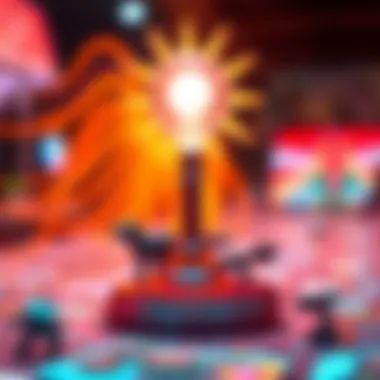Crafting and Selling NFTs: A Complete Guide


Intro
In recent years, the rise of non-fungible tokens (NFTs) has sparked an exhilarating wave within the digital landscape. It seems like everyone is diving into this sphere, from artists to collectors, eager to capitalize on what has become a cultural phenomenon. But talking about NFTs is not just hot air; it’s about understanding a nuanced market that intertwines technology, creativity, and economic principles. Whether you are an investor, a trader, or just curious, grasping this topic is vital for navigating the multifaceted world of NFTs.
This guide will dig into the details of crafting and selling NFTs, covering everything from key concepts to technical essentials, as well as exploring the various platforms where these tokens can be bought and sold. Additionally, we’ll discuss compelling marketing strategies, key price-setting considerations, and the legal intricacies involved in trading these digital assets.
So, if you want to master the art of NFT creation and sales, stick around. It’s time to roll up your sleeves and jump into the vibrant universe of non-fungible tokens.
Market Analysis
Current Trends in Cryptocurrency
The cryptocurrency market is a wild terrain. With Bitcoin and Ethereum blurring the lines of traditional finance, it's pivotal to keep an eye on ongoing trends. For instance, NFTs primarily thrive on the Ethereum blockchain, which affects their prices and desirability. As digital art gains traction, artists and creators are increasingly turning their gaze towards minting NFTs, thus driving the market in unexpected places.
Here are a few trends to note:
- Diversity of Use Cases: From virtual real estate to digital fashion, NFTs have extended their application beyond simple collectibles.
- Environmentally Friendly Solutions: With the rising concern about the environmental impact of blockchain, several projects are exploring eco-friendly alternatives.
- Cross-Chain Opportunities: More marketplaces are embracing multi-chain functionalities, providing users with flexibility and variety.
Price Prediction Techniques
Pricing NFTs is not as straightforward as it may seem. Speculators make guesses based on various factors, but trends can be fickle. Analyzing past sales, understanding the rarity of the asset, and observing market sentiments can provide insights into potential future valuations. Here are a few techniques that can aid in predicting prices:
- Market Sentiment Analysis: Following the buzz on social media platforms like Twitter and Discord can give hints about what’s hot.
- Historical Comparisons: Look at similar NFTs and their sales history as a reference point.
- Community Engagement: Communities can amplify the value; if an NFT has a strong following, it tends to perform better.
"In the world of NFTs, understanding the market landscape can mean the difference between profit and loss."
Investment Strategies
Long-Term vs Short-Term Investing
Investing in NFTs can be likened to a rollercoaster ride; it has its ups, downs, and unexpected turns. Here, understanding your investment horizon is crucial.
- Long-Term Investing: This strategy requires patience. Investors seeking potential appreciation might hold onto valuable pieces for years.
- Short-Term Trading: If you’re quick on the draw, flipping NFTs within a short timeframe could yield significant gains, although it comes with higher risk.
Risk Management in Crypto Trading
In the rapidly evolving world of digital assets, effective risk management is non-negotiable. Consider these tactics:
- Portfolio Diversification: Don’t put all your eggs in one basket. Hold a mix of NFTs and other crypto assets to mitigate risks.
- Set Clear Limits: Establishing stop-loss limits can help in avoiding catastrophic losses if a particular NFT plummets in value.
- Stay Informed: Keep yourself updated about market developments. Knowledge is power in a volatile environment.
By now, you should have a clearer picture of the current landscape and how to navigate it. Understanding market dynamics and employing sound strategies will set the stage for effectively crafting and selling your NFTs.
Understanding Non-Fungible Tokens
Grasping the concept of Non-Fungible Tokens (NFTs) is akin to unlocking a digital vault of creative potential. These tokens represent a unique intersection of technology and artistry, ushering in new ways to authenticate and monetize digital content. The crux of the importance lies not just in their novelty, but in the myriad possibilities they present to artists, collectors, and investors alike.
Defining NFTs
NFTs, at their core, are digital assets verified using blockchain technology. Unlike cryptocurrencies like Bitcoin or Ethereum, which are interchangeable, each NFT is unique, hence the term "non-fungible." Think of them as one-of-a-kind collectibles—the kind you wouldn’t trade for anything else. For instance, a digital painting might carry an NFT that certifies its originality, while a limited-edition video clip can also have its own unique token. This specificity transforms digital items, offering clarity on ownership and provenance.
The Technology Behind NFTs
Blockchain Overview
The backbone of NFTs lies within blockchain technology. This decentralized ledger ensures transparency, enabling anyone to verify ownership. A primary characteristic of blockchain is its immutability. Once data is recorded, it cannot easily be altered. This feature contributes significantly to the NFT marketplace, as it guarantees that the details related to ownership and transaction history remain intact and accessible.
While Ethereum is the most recognized blockchain for NFTs, other platforms like Flow and Tezos are gaining traction due to lower fees and energy-efficient processes.
Smart Contracts Explained
Smart contracts are self-executing contracts with the terms directly written into code. They play a pivotal role in NFTs by automating transactions, which reduces the need for intermediaries. A major characteristic of smart contracts is their reliability; they execute actions as programmed. This not only facilitates seamless transactions but also enables features such as royalties, ensuring creators earn a percentage every time their NFT is sold. However, coding errors can pose risks, highlighting the necessity for thorough audits.
Why NFTs Matter
Ownership and Authenticity


Ownership is perhaps the most significant advantage NFTs bring. In a digital world where content can be easily copied, NFTs provide verified ownership. This assurance encourages artists and creators to share their work, knowing that their intellectual property is protected. When collectors purchase an NFT, they are acquiring not just digital art but proof of authenticity, granting them a form of security against potential reproduction without consent. However, the market is still maturing, causing occasional confusion regarding rights.
Impacts on Digital Art and Collectibles
NFTs have revolutionized the digital art scene, providing a direct revenue stream for artists that was previously scarce. They allow creators to sell their work to global audiences without needing traditional galleries. This democratization of access is indeed a double-edged sword: while it opens doors for emerging artists, it also creates a saturated market where quality can fluctuate. Collectors no longer just own artworks but stories and experiences encapsulated in digital formats, changing perspectives on value and ownership in the digital age.
Conceptualizing Your NFT
In the complex landscape of NFTs, conceptualizing your digital asset is not just a preliminary step; it’s the very heartbeat of your project. This phase is critical as it lays down a foundation on which all other aspects of creating and selling your NFT will depend. By carefully identifying your niche and crafting unique content tailored to that space, you position your NFT to resonate within the targeted community while setting it apart from the sea of creations flooding the marketplace. Understanding the uniqueness of your concept not only dictates your creative process but also intimately ties into how well your NFT will attract potential collectors and buyers.
Identifying Your Niche
Artistic Approaches
When it comes to artistic approaches, the distinct styles, techniques, and themes you choose to explore can significantly impact your NFT's perception and value. An artist might develop a signature style characterized by a specific color palette or technique. This very characteristic often becomes synonymous with their identity in the NFT space, drawing collectors who are specifically interested in that style. Think of how Pixel Art, for instance, has carved a comfortable niche in NFT marketplaces, appealing to both nostalgia and modern aesthetic sensibilities.
What makes artistic approaches particularly beneficial in this context is their ability to forge an emotional connection. They carry the maker’s voice and sentiment, which makes the digitized artwork feel more than just another digital copy. However, you should also be aware that focusing on a niche can limit your audience. Balancing personal expression with market demand is thus essential. Keep in mind that in the world of NFTs, what grabs attention today might be old news tomorrow, so evolving your approach while retaining core elements can be advantageous.
Collectibles and Gaming
On the flip side, collectibles and gaming represent a different side of the creative spectrum in the NFT world. These NFTs often thrive on interactivity and the community aspect, making them highly attractive to both creators and buyers. The unique feature here is gameplay utility; items in games often hold inherent value beyond mere aesthetic appeal. For example, in games like Axie Infinity, players can breed, raise, and trade creatures, creating a thriving market in which rare Axies can fetch significant sums.
The core benefit of focusing on collectibles and gaming is the potential for ongoing engagement. Unlike static art pieces, these NFTs can evolve, offer rewards, and build a community of dedicated fans. Still, they come with their own challenges—developing game mechanics and ensuring ongoing interest can be resource-heavy and time-consuming. Therefore, any creator entering this space must not only understand the collectible's current market but also predict trends and maintain engagement over time.
Creating Unique Content
Design Considerations
In terms of design considerations, the visual dimensions of your NFT cannot be understated. The moment someone encounters your NFT, the design will play a critical role in human perception and value assessment. Factors such as color theory, composition, and even animation techniques can tremendously influence how an audience engages with your creation. A well-crafted design can tell a story and provoke emotion, making it more appealing to potential buyers.
Aside from aesthetic appeal, thoughtful design considerations may create a sense of exclusivity. Limited edition runs or unique traits in generative art can lead to buzz, sparking interest and driving sales. However, market saturation poses a risk—too many similar designs can dilute the perceived value. Hence, striking a balance between creativity and market trends is paramount.
Storytelling through Art
Art that tells a story, whether explicitly or implicitly, often resonates far deeper with viewers than mere visuals. When your NFT can convey a narrative, it gives collectors a reason to connect with it emotionally, which may lead to a stronger intent to purchase or share it. For example, the visual story behind an NFT can enrich the experience, making it more than just an investment—it becomes part of a larger conversation in the digital art community.
Unique features here include layered meanings and cultural references that can transform a piece into a topic of discussion among communities. On the downside, there’s the risk that not every viewer will catch the nuances of your storytelling. Finding ways to effectively communicate your narrative can sometimes prove challenging. Still, if done right, it enhances engagement and can foster a passionate following.
Conceptualizing your NFT is not just about the art; it’s about creating a rich context that elevates the entire experience.
Technical Aspects of Creating NFTs
In the world of non-fungible tokens, the technical aspects play a critical role. From the technology that supports these digital assets to the process of minting them, understanding these elements is essential for anyone serious about entering the NFT market. Not only do these technicalities determine how an NFT operates, they also influence the success of the creation and eventual sale of the token. Technical skills can be the difference between a token that's just another drop in the ocean, and one that shines bright in the vast sea of digital collectibles.
Choosing the Right Blockchain
Ethereum vs. Alternatives
Ethereum has long been the first thought that comes to mind when one discusses NFTs. It's like the bread and butter of blockchain technology. Its widespread adoption makes it a popular choice, not just for its well-established infrastructure but also for the incredible support from developers and its large community of users. One of the key characteristics that sets Ethereum apart is its smart contract capability, which allows creators to define the terms of the NFT themselves. However, alternatives like Binance Smart Chain, Solana, and Flow are emerging on the scene, each offering unique features and benefits.
For example, Binance Smart Chain offers considerably lower transaction fees, which can be a significant advantage when minting numerous tokens. Meanwhile, Solana boasts high scalability, enabling faster transaction times. These alternatives can be particularly appealing for artists looking to minimize costs while maximizing exposure.
Scalability and Fees
The aspect of scalability is paramount when it comes to blockchain selection. Scalability refers to a blockchain's ability to handle growth in transactions without slowing down. High transaction fees, especially during peak times, can deter potential buyers. This is where understanding fees comes into play. On Ethereum, transaction costs can fluctuate dramatically, leading to a frustrating experience for users. In contrast, many alternative blockchains like Tezos or Polygon offer lower and more stable fees.
It's also worth considering that lower fees can mean more accessibility for both creators and buyers. An emerging artist could mint their NFT without breaking the bank and buyers could acquire digital art without feeling like they're shelling out for a luxury item. Scalability and fees are closely linked and represent a vital factor in the broader topic of NFT creation and selling.
Minting Your NFT
Step-by-Step Minting Process
Minting your NFT can seem daunting without a roadmap. First things first, you need to pick the right platform for minting. Typically, this involves navigating to an NFT marketplace and connecting your digital wallet, like MetaMask. The step-by-step process typically involves uploading your digital asset, filling in relevant details like a name, description, and adding any specific royalties you wish to earn on future sales. After that, confirm your transaction, and voila, your NFT is live for all to see.
Learning the nuances of this process ensures that you'll be able to effectively create and distribute your work while understanding potential pitfalls. While every marketplace has slight variations in procedure, understanding the essentials can save both time and confusion.
Using NFT Marketplaces for Minting


Utilizing established NFT marketplaces like OpenSea or Rarible provides users with a streamlined experience that alleviates many technical headaches associated with minting an NFT. These platforms allow you to mint directly on their site without needing extensive blockchain knowledge.
They come equipped with tools designed specifically for creators to showcase their work effectively. However, relying too heavily on these marketplaces might limit your creative freedom. You may find that various platforms impose different rules regarding how your NFT is minted or sold. It's essential to explore multiple avenues and choose the one that aligns best with your vision for your digital asset.
In the volatile world of NFTs, the smooth navigation of technical aspects can significantly increase your chances of success in selling your creations.
Marketplaces for Selling NFTs
The rise of non-fungible tokens has opened a plethora of avenues for creators and investors alike. Marketplaces for selling NFTs play a pivotal role in this ecosystem, serving as the bridges between artists, collectors, and buyers. These platforms are not just mere venues; they determine how easily one can list, sell, or buy unique digital assets.
In a landscape where visibility and credibility matter, opting for the right marketplace can greatly influence the success of your NFT sale. Numerous factors come into play when considering these platforms. This section will explore some of the most popular NFT marketplaces, highlighting their features, strengths, and any potential pitfalls.
Popular NFT Marketplaces
OpenSea
OpenSea is often regarded as the go-to marketplace for NFTs, offering a vast collection from a myriad of creators. The sheer scale of OpenSea is a key characteristic, making it a beneficial platform for those looking to maximize exposure. One unique feature of OpenSea is the ability to create a customizable storefront, allowing artists to showcase their collections in a way that aligns with their brand.
However, being one of the largest comes with its own disadvantages, particularly concerning saturation—your NFT can easily be lost in the crowd. The fees can also stack up, particularly when gas prices fluctuate.
Rarible
Rarible positions itself as a community-driven marketplace where users not only buy and sell but also govern through its native token, RARI. This democratic approach offers a unique spin that attracts a certain segment of the NFT community. One of Rarible's standout features is its minting process; it allows creators to mint their NFTs directly, making the entry into the market relatively seamless.
Despite its user-friendly interface, Rarible has faced criticism for its royalty structures and occasional lack of curation, which means quality variations can be noticeable.
Foundation
Foundation is a marketplace designed with artists in mind, emphasizing exclusive access and curated collections. The key characteristic of Foundation is its invitation-only model, which not only creates a sense of prestige but also helps maintain quality. Artists feel encouraged to share their best work, knowing they are part of a curated space.
On the downside, this exclusivity means that emerging creators may find it challenging to gain entry, which could limit the diversity of offerings on the platform.
Navigating the Selling Process
Successfully selling your NFT involves more than just listing it on a platform. Understanding the selling process will allow you to optimize your approach and maximize your potential profits. This section will examine how to effectively navigate the intricacies of selling your NFT.
Listing Your NFT
Listing your NFT is a crucial step that can impact visibility and sales. When you list an NFT, you’re essentially opening the door to potential buyers. The key characteristic here is that different marketplaces often have distinct listing procedures and requirements. This can greatly influence your choice of platform.
A unique feature of the listing process is the option to add descriptions, tags, and even unlockable content to make your NFT stand out. Engaging and descriptive listings often lead to better sales performance. However, if you're not careful with your presentation, it can lead to misunderstandings or underwhelming sales.
Setting Reserve Prices
When you set reserve prices, you establish the minimum amount you are willing to accept for your NFT during an auction-style sale. This aspect is particularly vital because it helps to prevent underpricing your work, which is a common pitfall. The key characteristic of having a reserve price is that it allows you to control the sale outcome to some extent.
The unique feature here is that reserve prices can create a bit of intrigue—potential buyers might feel drawn to a bidding war if they see an NFT with a reasonable low reserve. However, setting it too high can deter interested parties from even considering your piece.
"A well-thought-out pricing strategy can be the difference between a sold and a lonely NFT."
In summary, the process of listing and determining reserve prices shouldn’t be taken lightly; they are foundational to your success in the NFT marketplace.
Marketing Your NFT
In the buzzing world of NFTs, marketing is pivotal. It's not just about creating a digital asset; it's about making sure it gets the spotlight it deserves. Marketing your NFT means amplifying its visibility, connecting with potential buyers, and establishing a brand that resonates within the community. In a nutshell, effective marketing can turn a forgotten digital doodle into a sought-after treasure.
Building Your Brand
Social Media Engagement
Social media is the lifeblood of modern marketing, and NFTs are no exception. Engaging with audiences on platforms like Twitter, Instagram, or TikTok can massively impact your NFT's reception. These platforms allow creators to share their work, connect with followers, and join conversations around NFTs. The immediacy and broad reach of social media make it an invaluable tool.
- Key Characteristic: Real-time interaction. This fosters a sense of community and keeps engagement levels high.
- Unique Feature: Platforms like Twitter Spaces allow live discussions and Q&A sessions, enhancing connectivity.
The advantages here are clear: you can showcase your creative journey, share insights, and cultivate relationships with enthusiasts and collectors alike. However, maintaining consistency can be a challenge, as you must regularly post and engage to keep your audience interested.


Creating a Personal Website
Creating a personal website is another powerful avenue for marketing your NFT. This space acts as a central hub where potential buyers can learn more about you and your art. A well-designed website not only displays your NFTs but also tells the story behind each piece, establishing a deeper connection with visitors.
- Key Characteristic: Control over branding. You can present your work exactly how you envision it.
- Unique Feature: A personal website enables you to create a portfolio that can be easily shared across different platforms.
However, building a website involves more than just setting it up. You need to invest time in SEO practices, ensuring it ranks well in searches. The disadvantage is that while social media can be immediate, a website takes effort to build and maintain but can pay off in the long term.
Leveraging Communities
Joining NFT Forums
Becoming an active member of NFT forums is crucial. These places are teeming with passionate individuals who share a love for digital assets. By participating, you not only keep abreast of market trends but also position yourself as a knowledgeable figure within the community. This can lead to opportunities, collaborations, or even sales.
- Key Characteristic: Information exchange. Forums allow for robust discussions that can sharpen your understanding.
- Unique Feature: The focus on niche topics ensures that dialogue is relevant and insightful.
The benefit of these forums is multifaceted; you gain exposure and validation from peers. But be mindful of balance – engaging meaningfully requires time, and getting lost in endless threads can detract from your actual creative work.
Networking with Other Creators
Networking with other creators opens a world of opportunities. Collaborations can lead to unique projects that combine your strengths and reach wider audiences. By connecting with others, you position yourself at the forefront of creativity while enriching your portfolio.
- Key Characteristic: Cross-promotion potential. When two creators collaborate, their audiences overlap, creating broader interest.
- Unique Feature: Networking can lead to partnerships that enhance credibility and exposure.
One significant advantage of networking is the infusion of new ideas and feedback that can refine your process. But this can demand extensive time and energy, and not every connection will yield meaningful interactions. The art lies in discerning who to engage with seriously.
Engaging in strategic marketing can transform not just the reach of your NFT, but its very perception in the burgeoning digital landscape.
Legal and Ethical Considerations
Navigating the complex world of NFTs requires more than just a flair for creativity or technical know-how. Understanding the legal and ethical landscape is paramount for artists, investors, and buyers alike. The significance lies in protecting one's intellectual property rights while ensuring fair practices across the marketplace. A misstep in this arena can lead to disputes that may overshadow the initial excitement of launching an NFT. A firm grasp on legal frameworks and ethical responsibilities not only fosters trust among community members but also fortifies your own standing in this burgeoning market.
Understanding Copyright
Copyright law is often a minefield for creators and sellers of NFTs. Simply put, copyright grants the original creator exclusive rights to their work, allowing them control over its use and distribution. However, when an NFT is created from existing artwork or media, who's to say where the rights lie? If you create an NFT based on a popular meme or an image lifted from a Google search, you may find yourself tangled in legal quandaries.
Here are a few essential points to ponder regarding copyright when creating NFTs:
- Originality Matters: Your NFT needs to be original, or you must have the required permissions if utilizing someone else's work. Failing to do this can lead to copyright infringement claims.
- Proof of Ownership: Blockchain technology can aid in establishing ownership. But remember, just because something is on the blockchain doesn't mean you've set the legal ground for using that content.
- Personal Brand vs. Community Trust: Upholding copyright laws is crucial for maintaining your credibility within the NFT community. Your reputation as a creator relies as much on ethics as it does on art.
Understanding and respecting copyright not only shields you from potential legal action but also emboldens your position as a savvy player in the NFT realm.
Platform Regulations
As you move forward in crafting and vending your NFTs, it's vital to keep an eye on the regulations set by various platforms. While platforms like OpenSea and Rarible offer user-friendly avenues to sell your creations, they each come with unique rules that dictate what can and cannot be sold.
Be mindful of these key platform regulations:
- Content Restrictions: Many platforms prohibit specific content types, such as hate speech, pornography, or anything deemed illegal. Familiarize yourself with these policies to sidestep surprises during the listing process.
- Royalty Structures: Different marketplaces have varied structures for artist royalties. Understanding these can greatly impact your revenue potential over time. Some platforms might offer higher percentages for creators per resale, while others may be less generous.
- Quality Control: Some marketplaces enforce quality checks, which may include assessing the authenticity and originality of the assets before accepting them for sale. This helps maintain a degree of integrity across the platform but can be a hurdle for new creators.
Being aware of platform regulations is crucial to avoiding pitfalls that could close doors on future opportunities. Fostering a good reputation relies not just on your work but also on understanding and complying with the space your NFTs inhabit.
Future Trends in the NFT Market
As the digital landscape continues to evolve, the NFT market stands at a crossroads. Not only does this pivot towards innovation indicate what’s ahead, but it also provides insights into how investors and creators can strategically position themselves. By understanding and anticipating future trends, participants in the NFT space can align their efforts with market demands, maximizing potential revenue and exposure.
Technological Advancements
The technological backbone of NFTs is ever-changing, and keeping pace with these advancements is vital. A few notable innovations include:
- Layer 2 Solutions: New technologies like Polygon are becoming more prevalent. They improve scalability and lower transaction fees considerably. This change means lower costs for consumers and creators alike, sparking broader interest in NFT marketplaces.
- Interoperability: There's a growing push for NFTs to exist across various platforms and blockchains. This can provide greater liquidity opportunities and widen the market for creators, enabling their works to reach a broader audience.
- Decentralized Finance (DeFi) Integration: As DeFi protocols start to interface with NFTs, it opens doors for novel financial products, such as NFT collateralization for lending. This may fundamentally shift how people view digital assets and their value.
Furthermore, advancements in augmented reality (AR) and virtual reality (VR) are influencing how NFTs are being experienced, giving life to digital art like never before. This transition could redefine the ownership experience, setting the stage for immersive interactions that blend the tangible with the digital.
Shifting Consumer Interests
Consumer behavior in the NFT space is fluid, sculpting the market landscape persistently.
- Sustainability Consciousness: With increasing awareness regarding environmental impacts, more buyers are gravitating towards eco-friendly NFTs. Tools that ensure lower energy consumption during mining or minting processes are becoming highly desirable.
- Variety in Utility: More consumers are keen on NFTs that offer tangible benefits. Social connections and access to exclusive events are high on the wishlist, merging both virtual assets and real-world experiences.
- Gaming and Virtual Worlds: There’s an uptick in interest for NFTs tied to gaming—skins, avatars, and even real estate in virtual worlds are proving to be hot commodities. This confluence of gaming and NFTs indicates that the youth today are looking for unique digital identities that can float across various platforms.
"The world of consumer interests is not just shifting; it's transforming, and it necessitates a reevaluation of what we deem valuable in the digital realm."
In summary, the future of NFTs lies not only in their artful representation but also in how they entwine with our daily lives and technological advancements. Familiarizing oneself with these trends will empower investors and creators to make informed decisions, helping them stay one step ahead in an ever-evolving marketplace.















